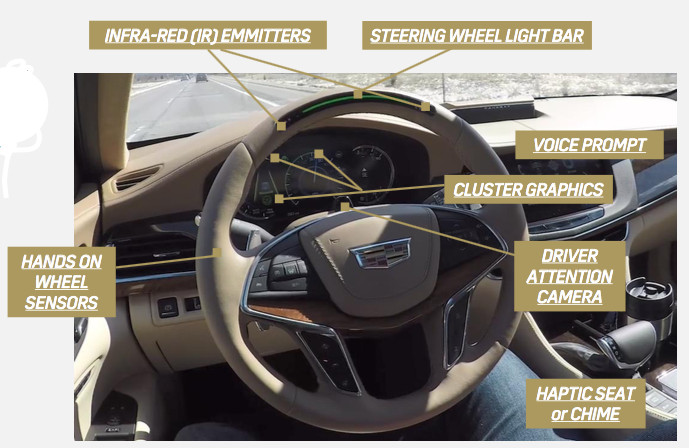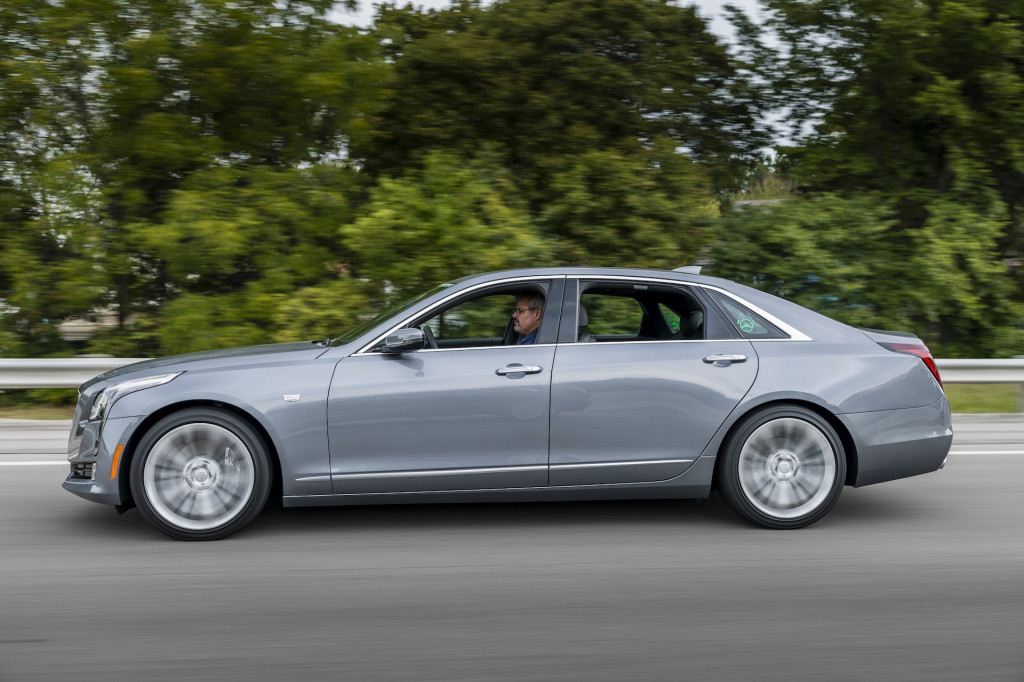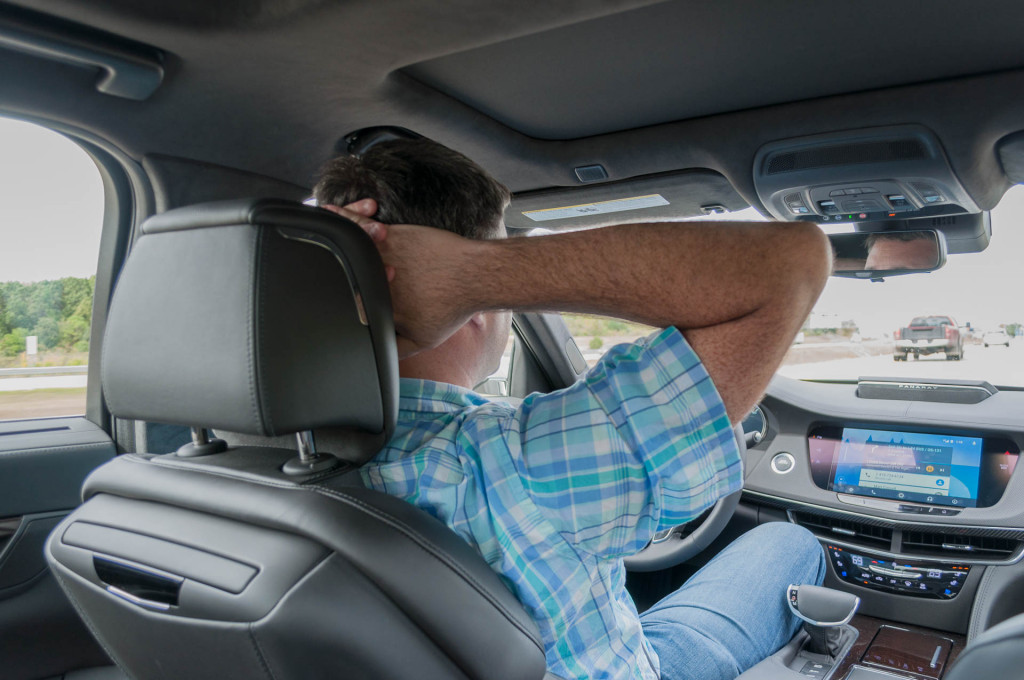When I was a kid, "The Jetsons" promised me flying cars would be part of the future, and I would have a robot housekeeper. It’s the future, and I don’t have either of those things.
Now, automakers are promising self-driving cars are the next big thing, and they will be on the road very soon...supposedly.
Cadillac’s launching its Super Cruise driver assist system, and it’s as close to a self-driving car as you’ll get on the road today. To put the system to the test, I slid behind the wheel of a CT6 for two long days to drive from Cleveland to Chicago and Chicago to Nashville. That was a lot of time behind the wheel, literally, as I didn't need my hands on the steering wheel. The time was well spent, though, because it showed what the system’s capable of, and whether Cadillac’s delivered on its promise of hands-free driving.
What it is and what it isn't
Turn it on and Super Cruise will take the over steering, throttle, and braking duties while on the highway at speeds of up to 85 mph, whether in traffic or in the middle of nowhere. Let’s be clear that Super Cruise doesn’t make the Cadillac CT6 a self-driving car. It’s an advanced driver assist system that allows for hands-free driving under certain conditions, and that’s it.
To use the system, you must be driving on a divided, limited-access freeways with defined exit ramps and no cross traffic. It will not work on major interchanges with undefined exits, and you should not use it in construction zones.
There are five levels of self-driving capabilities when it comes to autonomous cars, and this is a Level 2 system, which means the car can execute both steering and the throttle, but the driver must monitor the driving environment and emergency maneuvers will be the driver's responsibility.
Why isn’t it a Level 3 system? Super Cruise still requires you to monitor the driving environment, and it can’t perform lane changes or maneuvers without you pausing the system and taking control. Rob Bolio, Cadillac’s vehicle performance manger, told me the car’s hardware is capable of autonomous lane changes, but the software currently isn't. This could be changed in the future via an over-the-air (OTA) update, though Bolio said Cadillac found its customers don’t feel lane changing capability is a priority.

Cadillac Super Cruise
The system adds quite a bit of hardware to the CT6. It has an advanced map module that stores all the mapped LiDAR data, a steering column-mounted camera to watch the driver, six steering wheel-mounted infra-red (IR) emitters that help light your face so the camera can see your eyes even through sunglasses, two Super Cruise modules that are the brains behind the system, a redundant steering system as a backup, object detection modules that read if there are hazards in the road, and a super capacitor that acts as a backup in case there’s a fault with the CT6's main 12-volt system. Those features are in addition to a windshield-mounted camera system, and short- and long-range radar that are already part of the CT6’s adaptive cruise control system; Super Cruise taps into both of those.
The map module has 130,000 miles of highway mapped out using high-definition LiDAR. That equates to every major highway and interstate in the U.S. and Canada. The map data is fed 25 meters at a time as the system is being used.
Oh boy, is this thing patented. General Motors has 310 patents supporting Super Cruise, and 146 of those patents directly relate to the system itself.

Cadillac Super Cruise
Simple to use
Using Super Cruise is really simple: Push the steering-wheel mounted Super Cruise button to activate the system, center the car in the lane, wait for the green steering wheel icon to appear in the instrument cluster and the solid green LED light to appear on the top of the steering wheel, then let go of the steering wheel. You are now Super Cruising.
Want to make a lane change while Super Cruise is enabled? You can pause the system by simply grabbing the wheel, using your turn signal, and performing the lane change, then handing the steering back to Super Cruise by centering the car in the new lane and waiting for the solid green steering wheel LED light. While paused, the LED light on the steering wheel will blink blue, indicating the system is paused.

Cadillac Super Cruise
This isn't a set it and forget it system, though. While Super Cruise handles the steering and speed, you still must supervise. No, you can’t go and watch a movie, read a book, or put your makeup on. Want to send a text message, write a tweet, or see who liked your cat video on Facebook? The system makes it difficult, though not impossible, to do these tasks, as the steering column-mounted camera is always watching the direction of your head and eyes. If both aren’t on the road for more than 4 to 5 seconds the system will flash the green LED light on the steering wheel, as if to yell at you for being distracted and not supervising.
Fail to turn your attention back to the road within a few seconds and the system disengages, the steering wheel-mounted LED light flashes red, and the controls are handed back to the driver.
Should you not take control within another few seconds it will activate the car’s hazard lights, bring the car to a complete stop (yes, in the lane you were driving in—better hope the cars behind you are paying attention or you’ll have larger issues), and OnStar will call your car. Should you not pick up the OnStar call, first responders will be dispatched as OnStar will assume you're having a medical emergency at this point.
The system only works once you activate it. While active, the system handles simple curves in the road, and uses speed limit data, your current speed, and map curvature data to slow the car to the necessary speeds through the curves, then resumes the preset speed.
Should you encounter a tunnel, the system can go up to 0.62 miles using Dead Reckoning (a process in which one's position can be calculated, usually used on the sea or in the air, by estimating direction and distance traveled) thanks to on-board data that will continue the car on its current course.
To be crystal clear: You can't get into a CT6 with Super Cruise, program a destination into the navigation system, and tell it to drive you from your current location to your final destination. It only works on highways when you activate it, and if you need to make a turn, you'll have to pause the system as described above.

Cadillac Super Cruise
Works as advertised
In my two days of driving, I learned the system works 100 percent as advertised. In fact, it took quite a bit of effort to find a way to text or play on Facebook while behind the wheel. The camera watching your eyes can tell when you are trying to trick it. You essentially need to flick your eyes back onto the road every few seconds for a few seconds, making it somewhat of a hassle to text or play on your phone.
Think you can trick the camera with your polarized sunglasses? Think again. Cadillac says the steering column-mounted camera can see through sunglasses, and indeed it saw through my polarized Ray Bans. It was able to tell if my eyes were off the road or shut within 5.48 seconds. I timed it.
In more than 17 hours of driving the CT6 with Super Cruise, the system never failed to perform under the correct operating conditions when being used properly. And that’s the key: You need to use it within its operating conditions and know its limits. It's an excellent Level 2 system, but nothing more.

Cadillac Super Cruise
The wheel deal?
The main differentiators between Super Cruise and what other automakers are offering today are the mapped LiDAR data and the driver attention system. It’s clear that Cadillac has baked in a ton of safety into this setup, and it makes it even more apparent how fast and loose Tesla’s been playing with its Autopilot system, which has poorly-designed safeguards for its self-driving features that simply invite users to misuse and abuse the system putting themselves and others on the road at risk.
With every other system on the market today you must keep a hand on the steering wheel within certain intervals, and some require some sort of pressure or torque/resistance to show even further proof that you are present.
Cadillac’s Super Cruise doesn’t need that. I went hours without touching the steering wheel or pedals. I only had to brake for construction zones or to get off the highway.
Every 2018 Cadillac CT6 Platinum comes standard with Super Cruise, and it's part of a $5,000 package on Premium Luxury models.
Without a question, Cadillac’s delivered on its promise of hands-free driving.
We don’t have flying cars yet, or even self-driving cars, but suddenly having to touch the steering wheel or manage the throttle in rush-hour traffic or on a long road trip seems absolutely archaic.
Cadillac provided travel and lodging to Internet Brands Automotive to bring you this firsthand report.
